Sarah L. Johnson's Blog, page 41
August 20, 2020
Spindle and Dagger by J. Anderson Coats depicts a woman's necessary charade in 12th-century Wales
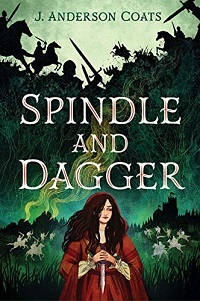 Coats’ newest historical novel is a penetrating portrait of women’s resilience and how they work through violent trauma. It’s based around a historical incident likely unfamiliar to its intended young adult audience: the abduction of Nest of Deheubarth by her second cousin Owain, Prince of Powys, during the increasing conflict between Welshmen and the land’s Norman invaders. Nest was married to Gerald of Windsor, leader of the Norman forces.
Coats’ newest historical novel is a penetrating portrait of women’s resilience and how they work through violent trauma. It’s based around a historical incident likely unfamiliar to its intended young adult audience: the abduction of Nest of Deheubarth by her second cousin Owain, Prince of Powys, during the increasing conflict between Welshmen and the land’s Norman invaders. Nest was married to Gerald of Windsor, leader of the Norman forces. The tale’s narrator is Elen, a richly complex fictional character. In 1109, Elen has solidified a place for herself in Owain’s warband as his nightly bedmate. Three years earlier, Owain and his men had attacked her family’s steading, killing her two sisters. Seeing no other alternative for survival, Elen healed Owain of his injury and declared—falsely—that Saint Elen would faithfully guard Owain’s life if he always kept her namesake close by. Owain believes in the saint’s protection, but his men are more dubious.
Tension remains high, evoking the political strain, and Owain augments it after his penteulu (right-hand man) is killed by the Normans, and he captures Nest and her three young children in revenge. This angers his father, Cadwgan ap Bleddyn, who fears paying the price for his hotheaded son’s act. Elen faces her own battles. The flashbacks to her earlier ordeal are delicately handled, and even now, Elen’s mind vies between the status quo—staying with Owain and remaining alive and cared for—and wanting to take a dagger and stab him. Elen desperately wants a female ally. While Owain’s stepmother, Isabel, proves hostile to the idea, Elen sees how Nest bravely endures her captivity and envisions how to escape her longtime charade.
This gritty tale of feminine strength deserves attention from all medieval history enthusiasts, from YAs through adults.
Spindle and Dagger was published by Candlewick in 2020; I'd reviewed it for August's Historical Novels Review based on a publisher-supplied ARC.
Some other notes:
- This novel is classified as YA, and the heroine is seventeen, I believe, but the themes are hardly juvenile. It would work well as a crossover novel, in the vein of Julie Berry's The Book of Dolssa and Elizabeth Wein's Code Name Verity. Along these lines, the cover art is attractive, yes, but it's clearly aimed at teen readers. Adult readers of historical novels shouldn't be dissuaded from picking it up by the art or the marketing category.
- I've been fascinating by the story of Nest of Deheubarth ever since reading Eleanor Fairburn's 1966 novel The Golden Hive, a biographical novel about her. Nest/Nesta has been called the "Helen of Wales" as she was a woman whose beauty supposedly drove men to war, but the reality was likely far different than the romanticized legend. Soon after I'd reviewed The Golden Hive for this blog in 2010, I'd received an email from the author, which was a nice surprise. As I recall, she had been debating finding a publisher to bring her work back into print, but this never happened. She died in 2015. I'd still love to see her work made more widely available. Getting back to the subject at hand, when Spindle and Dagger became available for review, I knew I'd have to read it.
- The author's earlier The Wicked and the Just is also set in medieval Wales, specifically the 13th century. It's on my list to read.
- You can find Spindle and Dagger on Goodreads, but be aware that many readers gave it a low rating because the e-ARC had more than the usual number of typos.
Published on August 20, 2020 05:48
August 16, 2020
The Summer Fields by LP Fergusson, romantic adventure set in the 18th century
 Fergusson’s unique historical romance reads like many novels in one: it patches together a creepy gothic story, horror fiction, and entertaining historical romantic adventure. In Radnorshire, Wales, in 1704, dairymaid Elen Griffiths is summoned from her father’s cottage by a local physician, Dr Argyll, who needs someone to tend to Viscount Mordiford at Duntisbourne Hall during his bout with smallpox. Elen is immune from the “red plague,” having had cowpox before, and her education means she’s well suited to be an aristocrat’s caregiver.
Fergusson’s unique historical romance reads like many novels in one: it patches together a creepy gothic story, horror fiction, and entertaining historical romantic adventure. In Radnorshire, Wales, in 1704, dairymaid Elen Griffiths is summoned from her father’s cottage by a local physician, Dr Argyll, who needs someone to tend to Viscount Mordiford at Duntisbourne Hall during his bout with smallpox. Elen is immune from the “red plague,” having had cowpox before, and her education means she’s well suited to be an aristocrat’s caregiver. Mordiford is disagreeable and the Hall exceedingly sinister, and Elen’s hopes of broadening her horizons vanish in the face of arduous nursing tasks and enforced isolation. Nearly a quarter of the novel takes place under these circumstances, which feel intensely claustrophobic. As Mordiford recovers his strength and sense of wit under Elen’s care (the methods are creatively unorthodox), Elen faces danger from another avenue. She befriends valet Ned Harley, and their connection turns romantic, but the Hall hosts debauched gatherings, and this time it’s Mordiford’s turn to save Elen from harm.
Following unusual circumstances, Elen boards a ship for The Hague with Dr Argyll, acting as his nurse as he travels with the army during the Duke of Marlborough’s campaign against the French. By then, she and Mordiford have acknowledged their attraction, although she despairs of finding him again on the war-torn Continent, and any shared future seems doubtful.
Fergusson brings to life Marlborough’s campaign up to his victory at Blenheim from the viewpoint of medical personnel, who deal with the traumatic aftermath of battle. The ending is too neat, and Elen and Mordiford have few chances to spend time together when he’s healthy, but it’s a well-researched story, particularly regarding early 18th-century medical treatments. Recommended for romance readers wanting a change of pace.
The Summer Fields was published by the digital publisher Canelo in the spring; I reviewed it for May's Historical Novels Review from a NetGalley copy. Find it on Goodreads here.
Published on August 16, 2020 12:32
August 13, 2020
Book review: The Secret Music at Tordesillas by Marjorie Sandor
 “Inside one note, many more are hidden.” For her first novel, National Jewish Book Award winner Sandor imagines the life of a converso musician in the retinue of the Spanish queen Juana I of Castile.
“Inside one note, many more are hidden.” For her first novel, National Jewish Book Award winner Sandor imagines the life of a converso musician in the retinue of the Spanish queen Juana I of Castile.After his sovereign lady’s death during her long confinement at Tordesillas in 1555, Juan de Granada tells his richly poetic account to two inquisitors of the Holy Office charged with finding secret Jews. Juana was never meant to be her parents’ heir, and her unrequited devotion to her handsome husband and others’ desire for control of her realm prompt rumors about her mental state. Her lady-in-waiting Inés de Castro, who becomes Juan’s love interest, is a complicated woman with dangerous secrets.
Infusing her work with elements from a unique confluence of cultures and religions in Spanish history, Sandor vividly contrasts people’s public roles with their covert beliefs and desires. At times, the language’s abstractness may have readers longing for greater clarity, but Sandor’s prose is seductive, akin to musical notes expressed on the page, and she presents a new, affecting view of a tragic royal figure.
The Secret Music at Tordesillas was published by Hidden River Arts as a paperback in June; this review first ran in Booklist Online this week. The book was the first winner of the publisher's Tuscarora Award in Historical Fiction. I recognize some other authors' names among the finalists and semifinalists and hope to see their books in print one day, too.
Published on August 13, 2020 16:21
August 10, 2020
A gallery of 12 forthcoming historical novels for summer and autumn 2020
I don't know about you, but I'm looking ahead to late summer and fall reads. Forthcoming in the next few months are a bumper crop of historical novels, ranging from new releases by longtime reader favorites to debuts from talented newcomers. While WWII settings are still holding steady in popularity within the genre, there's plenty on offer for readers seeking to expand beyond this time frame and the 20th century in general. Below are just a dozen among many that caught my attention, in order by author surname.
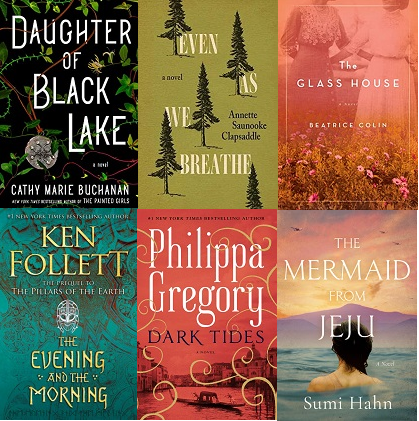
Cathy Marie Buchanan moves back in time to pagan 1st-century Britain with Daughter of Black Lake (Riverhead, Oct.) while Annette Saunooke Clapsaddle's Even As We Breathe (Univ Press of Kentucky, Sept.) follows a young man from the Cherokee Nation into WWII-era intrigue. The Glass House (Flatiron, Sept.), the final novel from the late Scottish novelist Beatrice Colin, tells a story of secrets and friendship in early 20th-century Scotland.
The Evening and the Morning (Viking, Sept.), the highly anticipated prequel to The Pillars of the Earth, Ken Follett's best known epic, focuses on the English settlement not yet known as Kingsbridge around the time of the first millennium CE. Another series entry, Dark Tides (Atria, Nov.) by Philippa Gregory, picks up her heroine Alinor's story, following her trials in Tidelands, in Restoration-era London. The Mermaid of Jeju (Alcove, Dec), Sumi Hahn's debut novel, centers on the haenyeo, female deep-sea divers, on Korea's Jeju Island after WWII.
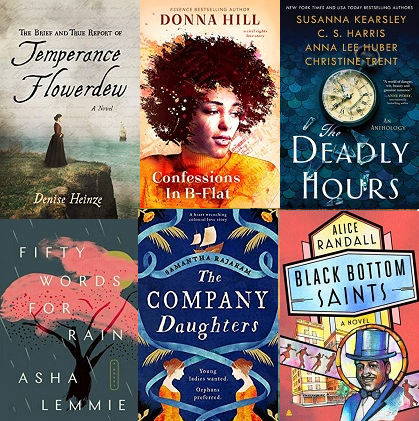
There are three debut novels in this second collage. Denise Heinze's The Brief and True Report of Temperance Flowerdew (Blackstone, Sept.), the first of these, takes its name from the historical woman who married two Governors of Virginia in the early 17th century. Confessions in B-Flat by the prolific Donna Hill (Sideways, Nov.), is a love story taking place in New York during the 1960s civil rights movement and Vietnam War years. For The Deadly Hours (Sourcebooks, Sept.) newest in a growing collection of multi-author collaborative projects, Susanna Kearsley, C.S. Harris, Anna Lee Huber, and Christine Trent trace the story of a mysterious gold watch and those it affects, beginning in the 18th century.
Two more debuts: Asha Lemmie's Fifty Words for Rain (Dutton, Sept.) has the unique viewpoint of a young girl of African-American and Japanese heritage in post-WWII Japan, and her search for her rightful place in a world that continually rejects her. The Company Daughters (Bookouture, Oct.) by Samantha Rajaram journeys along with its two heroines on their voyage from Amsterdam to marry settlers in the Dutch East Indies in the early 17th century. And, last alphabetically, Alice Randall's Black Bottom Saints (Amistad, Aug.) is set amid Detroit's historic Black Bottom neighborhood in the 1930s-40s and centers on the stars of this locale's famous art and culture scene.

Cathy Marie Buchanan moves back in time to pagan 1st-century Britain with Daughter of Black Lake (Riverhead, Oct.) while Annette Saunooke Clapsaddle's Even As We Breathe (Univ Press of Kentucky, Sept.) follows a young man from the Cherokee Nation into WWII-era intrigue. The Glass House (Flatiron, Sept.), the final novel from the late Scottish novelist Beatrice Colin, tells a story of secrets and friendship in early 20th-century Scotland.
The Evening and the Morning (Viking, Sept.), the highly anticipated prequel to The Pillars of the Earth, Ken Follett's best known epic, focuses on the English settlement not yet known as Kingsbridge around the time of the first millennium CE. Another series entry, Dark Tides (Atria, Nov.) by Philippa Gregory, picks up her heroine Alinor's story, following her trials in Tidelands, in Restoration-era London. The Mermaid of Jeju (Alcove, Dec), Sumi Hahn's debut novel, centers on the haenyeo, female deep-sea divers, on Korea's Jeju Island after WWII.

There are three debut novels in this second collage. Denise Heinze's The Brief and True Report of Temperance Flowerdew (Blackstone, Sept.), the first of these, takes its name from the historical woman who married two Governors of Virginia in the early 17th century. Confessions in B-Flat by the prolific Donna Hill (Sideways, Nov.), is a love story taking place in New York during the 1960s civil rights movement and Vietnam War years. For The Deadly Hours (Sourcebooks, Sept.) newest in a growing collection of multi-author collaborative projects, Susanna Kearsley, C.S. Harris, Anna Lee Huber, and Christine Trent trace the story of a mysterious gold watch and those it affects, beginning in the 18th century.
Two more debuts: Asha Lemmie's Fifty Words for Rain (Dutton, Sept.) has the unique viewpoint of a young girl of African-American and Japanese heritage in post-WWII Japan, and her search for her rightful place in a world that continually rejects her. The Company Daughters (Bookouture, Oct.) by Samantha Rajaram journeys along with its two heroines on their voyage from Amsterdam to marry settlers in the Dutch East Indies in the early 17th century. And, last alphabetically, Alice Randall's Black Bottom Saints (Amistad, Aug.) is set amid Detroit's historic Black Bottom neighborhood in the 1930s-40s and centers on the stars of this locale's famous art and culture scene.
Published on August 10, 2020 05:00
August 7, 2020
The original Mrs. Robinson's story: Brontë’s Mistress by Finola Austin
 Finola Austin’s perceptive debut imagines the first-person viewpoint of Lydia Robinson: the woman notorious in Brontë lore for supposedly having seduced her son’s tutor, Branwell Brontë, with the end of their affair leading to his dissolution, depression, and early death. But is this a fair assessment?
Finola Austin’s perceptive debut imagines the first-person viewpoint of Lydia Robinson: the woman notorious in Brontë lore for supposedly having seduced her son’s tutor, Branwell Brontë, with the end of their affair leading to his dissolution, depression, and early death. But is this a fair assessment?Among historical fiction subjects, this is about as “high concept” as it gets. It’s surprising no other novelist has previously claimed her as a protagonist, and it’s also fortunate that this character – the original Mrs. Robinson – was taken on by a writer capable of doing justice to this troubling, baggage-laden historical figure.
The main setting is Thorp Green Hall in Little Ouseburn, a village not far from York, beginning in 1843. Having lost her beloved youngest daughter and her mother in close succession, Lydia is overcome by grief. With her twenty-year marriage to Edmund Robinson having gone cold, her teenage daughters occupied with their own concerns, and the family governess (the overly serious Anne Brontë) spurning any hope of friendship, Lydia feels like nobody sees her for herself. Even her own name, in a sense, has been supplanted, as she shares it with her pretty eldest daughter.
When Miss Brontë’s flame-haired poet brother, Branwell, appears on the scene to tutor Lydia’s son, Ned, their shared interests in music, theatre, and literature create a spark between Branwell and Lydia, even though he’s twenty-five, while she’s eighteen years older. Their romantic encounters demonstrate Austin’s skill as a writer; there’s an awkwardness about them that evokes less of a grand, perfect passion than the result of two people’s desperate and individual cries for attention. Both come alive as real people with many flaws and rough edges, between Branwell’s neediness and alcoholism and Lydia’s selfishness, especially since her daughters are of an age when they need a mother’s loving guidance.
Rather than developing a story about Lydia’s downfall and redemption, which would feel both simplistic and false, Austin creates in Lydia a multifaceted portrait of an unhappy, neglected wife and mother whose passionate nature is suppressed by everyone around her: her distant husband, her overbearing mother-in-law, and society as a whole. Once she begins acting on her desires, though, she discovers she wants more from a partner than what Branwell can give. At the same time, alas, the rumors of adultery become impossible to contain. Lydia’s questionable choices make her difficult to admire, while at the same time, one can’t help but hope she’ll find fulfillment. One can also appreciate how Lydia's impressions of all her relationships shift over the course of the story, as she looks back on what each of them brought her.
The language and dialogue have a Victorian feel without seeming archaic, and the characters’ social milieu reflects the period, too. Lydia Robinson may be best known as “Brontë’s mistress,” but as Austin shows, she's much more than this. In fact, one of the novel’s greatest accomplishments is its moving illustration of how women are diminished when defined by their relationships to men.
Brontë’s Mistress was published by Atria this week (I reviewed it from an Edelweiss copy).

Published on August 07, 2020 05:00
Another quick note: comments re-enabled
Comments are now enabled as before. My attempt to restrict them had the unfortunate effect of turning off commenting altogether for most readers; the Blogger platform allows for few choices in how to configure it. As for the spam, it's back, but I'll continue dealing with it while exploring other options for controlling it. Thanks for your understanding!
Published on August 07, 2020 04:56
August 4, 2020
Passing Fancies by Marlowe Benn, a Jazz Age mystery set amid the Harlem Renaissance
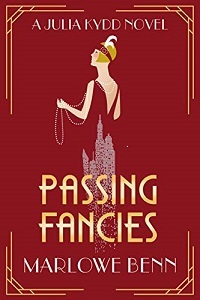 The title of this sophisticated second entry in the Julia Kydd mystery series (after Relative Fortunes) is cleverly apropos. It’s set in Manhattan during the freewheeling Jazz Age, circa 1924, which conjures up images of frivolous, fun-loving pursuits, but here, “passing” also refers to racial identity and crossing the color line.
The title of this sophisticated second entry in the Julia Kydd mystery series (after Relative Fortunes) is cleverly apropos. It’s set in Manhattan during the freewheeling Jazz Age, circa 1924, which conjures up images of frivolous, fun-loving pursuits, but here, “passing” also refers to racial identity and crossing the color line.Julia, a wealthy 25-year-old recently recovered from the near loss of her inherited fortune, is a bibliophile with ambition. She dreams of expanding her small private press, and for this, she needs authors.
At a publishing soiree, she meets the tall, fair Eva Pruitt, an up-and-coming novelist, and they develop a close rapport. Later, Julia is startled to learn that Eva is Black; Eva’s debut, it’s implied, will be a roman à clef about her experiences as a Harlem nightclub performer. When Eva’s manuscript (she only had one copy; one can sense all authors cringing) goes missing, and her boss is found dead, Eva’s the most likely suspect, but Julia can’t believe she did it.
Set amid the Harlem Renaissance, the themes of this novel taking place nearly a century ago are also unerringly modern, including police brutality, African American writers’ difficulties with the publishing industry, and white blindness to racial inequities. Eva is a well-rounded character with a complicated past, though her friendship with Julia blossoms too swiftly. Those enamored of fine bindings and quality fonts can indulge in their passions along with Julia, and language aficionados will appreciate the cultured writing.
As with the previous book, Julia’s one-time nemesis and half-brother, the urbane Philip, who helps to solve puzzlers for the police, is probably the most interesting character of all. He and Julia make a good investigating team, a revelation Julia slowly catches onto.
Passing Fancies was published by Lake Union in 2020 (I reviewed it from NetGalley for August's Historical Novels Review).
Published on August 04, 2020 06:02
Quick note: Comment policy temporarily changed
I appreciate it when blog readers take the time to comment on one of my posts. Over the last few weeks, though, so many unpleasant spam comments have been arriving that I've had to take action. Comments are moderated, so the spam never shows up on the blog, but I still have to manage and delete them all, and they were getting through even with word verification turned on. In order to deter the bots, I've temporarily set comments to blog members/followers only, and it seems to be working. Apologies for the inconvenience. I plan to lift this later on and see if the situation has improved.
I also welcome thoughts and comments via the blog's Facebook page.
Thanks for continuing to read my reviews and other posts!
I also welcome thoughts and comments via the blog's Facebook page.
Thanks for continuing to read my reviews and other posts!
Published on August 04, 2020 04:57
July 30, 2020
Vanessa Riley's multicultural Regency romance A Duke, the Lady, and a Baby
 In the author’s notes at the end of her lively new historical romance, Vanessa Riley reveals that England was the home to at least ten thousand people of Black or mixed-race ancestry during Jane Austen’s time. Regency romances typically feature love stories between members of the white aristocracy. Fortunately, a growing number of writers have been creating characters representing the diversity among the English populace at the time.
In the author’s notes at the end of her lively new historical romance, Vanessa Riley reveals that England was the home to at least ten thousand people of Black or mixed-race ancestry during Jane Austen’s time. Regency romances typically feature love stories between members of the white aristocracy. Fortunately, a growing number of writers have been creating characters representing the diversity among the English populace at the time. This first book in the Rogues and Remarkable Women series introduces Patience Amelia Jordan, former Duchess of Repington, a courageous young heiress originally from Demerara in the West Indies (now part of Guyana). Ever since her husband Colin’s suicide, Patience has been treated abominably by Colin’s uncle, who had her thrown into Bedlam for a trumped-up reason.
Now she’s forced to sneak into her marital home, Hamlin Hall, disguised as a groom in order to feed and watch over her son, Lionel. Then the new Duke, Busick Strathmore, arrives to take up his position and Lionel’s guardianship, starting afresh by dismissing all his predecessor’s staff. With the support of the Widow’s Grace, a group of widows helping her regain custody of her child, Patience becomes Lionel’s wet nurse and nanny while seeking evidence about the true nature of Colin’s financial dealings and mysterious death. Over time, Patience and the Duke form a tentative alliance that turns flirtatious and develops into love.
Their connection may seem subdued and cerebral, at first, when compared with other romance novels. However, I found Riley’s style of subtle, character-driven love story a refreshing change. Repington is a wounded soldier who had lost his leg during the Siege of Badajoz and, while adjusting to his new situation, plans his return to the battlefield. He quickly comes to love Lionel, though as a military man, his child-rearing methods are amusingly rigid.
Patience is a loving mother who wants only to return to her island with Lionel, but the Duke may change her mind. Riley also draws on elements of Patience’s cultural heritage to illustrate who she is. I particularly liked the scenes in which she debates praying to the Demararan god of protection but wasn’t sure if he had any control over what happened in England, and another where she dons a traditional, marigold-colored dress that her beloved late mother crafted. I did wonder why the Duke didn’t uncover Patience’s real identity sooner, and the shifts between Patience’s first-person viewpoint and the Duke’s third-person perspective feel unnecessarily distancing. Overall, though, I enjoyed this romance between two courageous, kind people, both outsiders in different ways, who genuinely respect each other. Patience’s marriage with Colin seemed a bit shaky, but I sense that her new relationship will endure.
And as for “Busick” – it’s not a traditional romance name, but it fits the period. (For example, Sir Busick Harwood was a well-known English physician who died in 1814, the year this novel takes place).
A Duke, the Lady, and a Baby was published by Kensington on June 30 (I read it from a NetGalley copy).
Published on July 30, 2020 14:36
July 26, 2020
Love, war, and atonement: Universe of Two by Stephen P. Kiernan
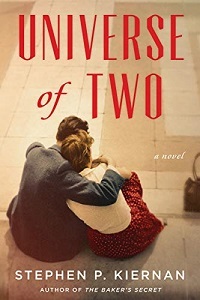 Kiernan (The Baker's Secret, 2017) movingly charts a couple’s relationship alongside the development of WWII’s Manhattan Project.
Kiernan (The Baker's Secret, 2017) movingly charts a couple’s relationship alongside the development of WWII’s Manhattan Project.In 1943 Chicago, fun-loving Brenda Dubie first meets Charlie Fish, a skinny mathematician (inspired by the historical Charles Fisk), when he visits her family’s music shop. Over time, Charlie’s increasing technical expertise leads to his reluctant transfer to Los Alamos. Ignorant of his top secret and pivotal role in building detonators, Brenda urges Charlie to do his patriotic duty.
The characterizations feel bracingly real. Brenda’s youthful, self-centered haughtiness prevents her from appreciating Charlie’s finer qualities; Charlie’s earnest devotion to his work and Brenda drives him to actions with ramifications he doesn’t understand until later. Brenda is a challenging heroine, but her wistful reminiscences, as she looks back decades later, demonstrate her emotional growth.
Kiernan recreates the zeitgeist of America leading up to the atomic bomb on a national and personal level: the eager anticipation of wartime’s end, the grimly fascinating science, and the growing sense of guilt and dread. Simultaneously tender and hard-hitting, this riveting story offers much to reflect upon.
Universe of Two will be published on August 4th by William Morrow/HarperCollins. This review ran in Booklist's April 1st issue (reprinted with permission). The novel was originally scheduled for May publication but was delayed, as has been happening frequently in the industry, due to the pandemic. I read it from an Edelweiss e-copy.
Additional thoughts: when it comes to fictionalizing historical characters and their experiences, authors have several approaches to consider. In creating an imagined character closely based on mathematician Charles B. Fisk, but who isn't him, Kiernan grants himself the freedom to deviate from the real person's life in order to tell the story he wants. As such, readers are able to separate the two men (one real, one fictional), and also learn more about Fisk afterwards if they wish to.
Published on July 26, 2020 10:42



